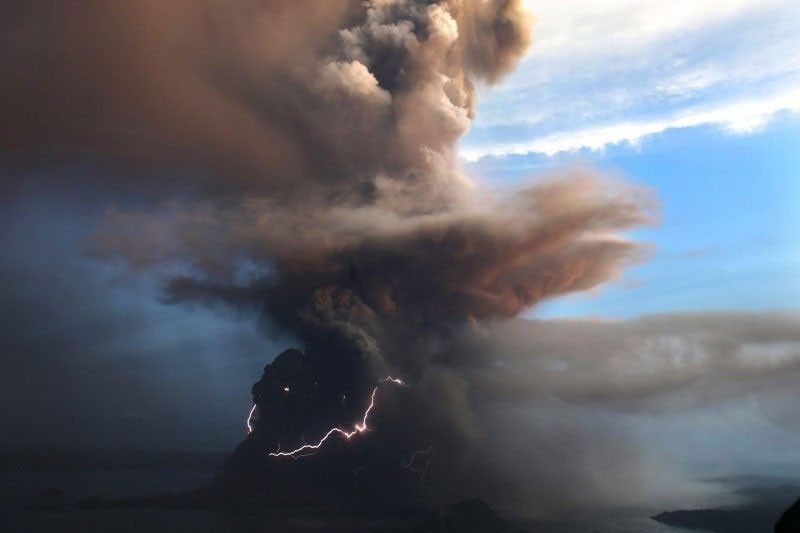Volcanic tsunami feared in Taal

MANILA, Philippines — As Taal Volcano began spewing lava yesterday, state volcanologists warned of “hazardous eruption” within days – with a force strong enough to unleash a “volcanic tsunami” that could swamp lakeshore communities.
Officials of the Philippine Institute of Volcanology and Seismology (Phivolcs) also warned that Taal’s unrest could last for at least three days and up to seven months, disrupting the lives of tens of thousands of people living around the country’s most active volcano.
Phivolcs chief Renato Solidum told “The Chiefs” yesterday on Cignal TV’s One News that a “lateral eruption” is possible, with volcanic fragments traveling up to 60 kilometers per hour across Taal Lake and hitting the lakeshore areas. So far, the volcano has had only vertical explosions, he said.
In a volcanic tsunami, magma from an eruption could displace water in the lake, creating a powerful wave that could hit lakeshore communities.
As residents in many areas in Southern Tagalog as well as parts of Metro Manila and Central Luzon started cleaning their ash-covered roofs and cars, the state weather agency cautioned that it would take about three days before the ash particles settle from the atmosphere.
“If we look at the historical eruptions of Taal, it could be as short as three days like in 1911, wherein the magmatic phase occurred from Jan. 27 to 30, 1911. Or it could last for seven months like the 1754 eruption,” said Mariton Bornas, chief of the Phivolcs’ Volcano Monitoring and Eruption Prediction Division.
Alert Level 4, which means that a hazardous eruption is possible within days, remained hoisted over Taal as of last night.
A volcanic tsunami is possible if Taal’s status is raised to the highest alert level – 5 – indicating a life-threatening magmatic event, the agency said.
According to Phivolcs, a volcanic tsunami may occur in Taal caldera lake when water is displaced by the deformation of the lake floor caused by rising magma.
The volcano sits within the 234-square kilometer lake formed by very large eruptions 100,00 to 500,000 years ago.
A magmatic eruption or weak lava fountaining accompanied by thunder and flashes of lightning were observed between 2:49 a.m. and 4:28 a.m., Phivolcs said.
Phivolcs also recorded a total of 144 volcanic earthquakes in Taal since Sunday, with intensities ranging from 1 to 5 in Tagaytay City; Alitagtag, Lemery, Santo Tomas and Talisay, Batangas.
“The intense seismic activity probably signifies continuous magma intrusion beneath the Taal edifice, which may lead to further eruptive activity,” Phivolcs said.
Apart from volcanic tsunami and lahar, fissuring, landslides, ground liquefaction are also possible, according to Bornas. Buildup or even release of lahar is likely in the portion of Laurel, Batangas, she added.
“The rivers are larger there (Laurel). In other parts of Taal, the slope is steep so it’s hard for debris to accumulate. But in this side of Laurel, there’s a plain there and bigger drainage of the rivers could generate lahar,” she said.
On Sunday afternoon, a phreatic or steam-driven explosion unleashed dark volcanic ash and lapilli or rock fragments of around two to 64 millimeters in diameter, prompting officials to raise alert level from 1 to 4 in hours and order the evacuation of dwellers on Taal island.
Heavy ashfall continued to blanket areas in the southwest sector of the volcano, including Cuenca, Lemery and Taal in Batangas.
Health experts advised the public to wear N95-grade face masks or wet cloth or towel when going outdoors as fine ash particles and sulfurous smell can cause irritation and breathing problems among the elderly and children. Long-term exposure to such may be harmful to the respiratory system.
A shift in wind direction will also spare Metro Manila and Central Luzon areas from more ashfall, according to the Philippine Atmospheric, Geophysical and Astronomical Services Administration (PAGASA).
PAGASA senior weather forecaster Chris Perez explained the prevailing wind direction in the “mid- and higher altitude” on Sunday carried the ash particles to areas north of Taal, including Metro Manila, to as far as Central Luzon.
“Last Sunday, the prevailing wind (five kilometers above ground) was from south to north, that’s why the ashfall reached Metro Manila. But starting this (Monday) morning, the wind was coming from southwest to west or toward Rizal, Quezon and Laguna,” he said
Perez also said the low-pressure area off Hinatuan, Surigao del Sur was not expected to affect winds and weather around Taal in the next two days.
The weather system was also not expected to develop into a tropical cyclone in the next few days.
Perez warned the public of the harmful effect of acid rain caused by volcanic activity.
He said acid rain could cause skin diseases as well as weaken structures, inflict damage on agricultural crops and aquatic environment.
- Latest
- Trending





























